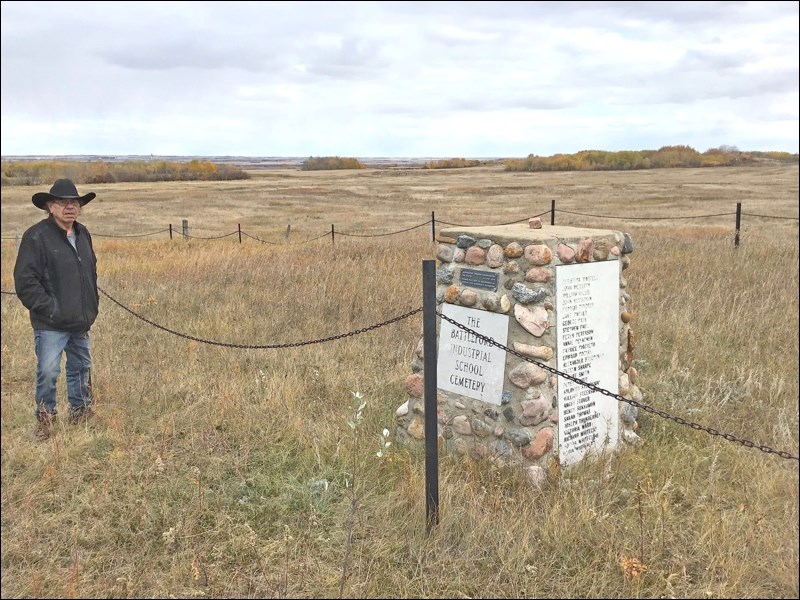A group of Indigenous leaders are expressing interest in purchasing land owned by the Oblates of Mary Immaculate in the government house area, with a view to adding healing lodges and other buildings there.
Individuals including Don Favel, who does special projects for Duane Antoine of Poundmaker First Nation, as well as representatives from Métis Nation of Saskatchewan were at the site Wednesday, Oct. 9.
Favel explains Poundmaker and the Battlefords Tribal Council had been interested in obtaining the land from the Oblates of Mary Immaculate located south of the town of Battleford.
The area is the former location of Government House when Battleford was the territorial capital, and also housed the Battleford Industrial School.
The First Nations interest in acquiring the land is motivated by a desire to advance reconciliation efforts. The site is of particular significance to First Nations people as it was the former location of the Battleford Industrial School – a residential school – and because of its proximity to the Industrial School cemetery. The cemetery includes graves of 74 people who either attended or were staff at the school, many of whom were children.
There has been local interest in preserving the cemetery and gaining heritage designation for the site, so future generations are aware of the legacy of residential schools which saw the displacement of Indigenous children and loss of their culture.
But the land where the cemetery is located was sold to private interests years ago, and the cemetery itself is hard to locate even on a Google map. Favel admits he did not know it existed until recently.
“I only found out about the graves a couple of years ago,” said Favel. “We met with this SaskPower guy and he was the one who told us about the cemetery.”
Favel said he began negotiations with the treasurer of the Catholic church out of Ottawa, and the initial request had been to gift the land to First Nations people, because they were the ones who attended both the Battleford Industrial School as well as the Delmas residential school.
That effort fell through, Favel said, because “they wanted $1,045,000 for it.”
They then went back and decided they were prepared to offer that amount to the Catholic church, but “then we were told they didn’t want to sell it, so we left it.”
Now, the Oblates have put the land up for sale. Favel said they learned the Oblates were selling a portion of the land to the Town of Battleford for $75,000 – a lot less than what the band had offered.
That news had thrown Favel for a loop, because they had already made a bigger offer. Nevertheless, they are now ramping up their efforts to acquire the entire property.
“So the Chief said follow it up, and we’re still trying to get ahold of that land,” said Favel. “Not only for future use, but as reconciliation and as an act of forgiveness for what they’ve done to us.”
The Métis Nation of Saskatchewan has lent their support in partnership, because “they were just as hurt through all this stuff as us,” said Favel.
The hope they have is to put in a long-term addictions healing centre as well as an elders’ care home and training centre at the site. The idea is for the healing centre to be long-term in nature.
“I know 28 days is not enough to send them home and right back without any followup or long term care,” Favel said.
The Métis Nation of Saskatchewan would be part of the group involved in that project.
The land in question is close to 100 acres, Favel estimates. Other sources put the figure at closer to 80 acres.
The Indigenous group is also hoping to acquire the Industrial School cemetery, but that would involve negotiations with the private owner. The cemetery is located within walking distance on fenced-off private property, which means people must get through a wire fence and walk through a field to be able to access the site.
For their part, the First Nations group says they want to acquire it so they can provide better upkeep to the site than what they are seeing now.
In contrast, they point to the well-maintained priests’ and nuns’ cemetery. Favel wants to see both cemeteries maintained to the same standard if they acquire the property.
“We will take care of the priests’ and nuns’ cemetery, just as well as being looked after. It’s all part of working together and getting over all the bad things that happened.”
The next steps will be to try and organize a feast and bring some elders and healers to a pipe ceremony.
“Something should be done to send those children off, their spirits off, to where they belong,” Favel said.



